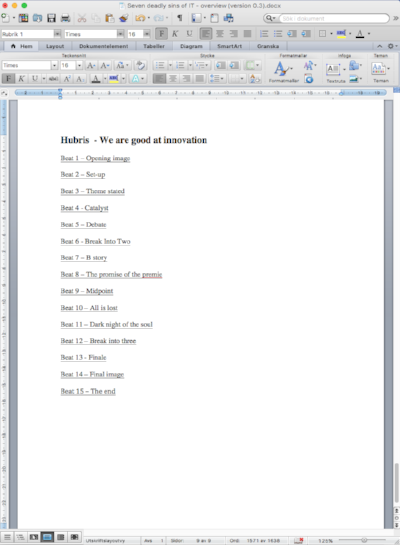15 beats per sin
A manuscript is like a set of requirements for software development,
Greger started with a synopsis for each sin and five different characters to be present in each short film and I had to plan the project.
In order to write a waterfall project plan, you have to break down your project in smaller parts in order to estimate effort and time. The synopsis of Sevens Sins is not on a enough detailed for a making a realistic plan.
I'm fond of using best practices so I went to Blake Snyder for some good advice. The recommendation in his book, Save the Cat, is to use 15 beats for a story.
A as start, I created seven different stories, with 15 beats in each of them in a word document as a template for the manuscript. When doing the template, I didn’t use the synopsis as input. That had to wait a little while,
If you are used to Scrum as a method, you could see each story as an epic and each beat as a theme.
In filmmaking, one of the most critical elements is a scene. A scene is generally thought of as the action in a single location and continuous time - an association of time, place or characters. If there are changes to the location, time or actors, there will be a new scene.
Without scenes, the manuscript is nothing more than a blank piece of paper. The same goes for a software project without requirements.
Comparing to the agile world, each scene is more or less like a user story. An actor does something in a scene. An actor does something in a user story. In both cases the are limited in scope with clear boundaries.
Now was it the time to bring up the synopsis.
"A retail company is struggling with it’s business and the CEO is looking for new ways forward and is ready to jump on any trend and falls for all sevens sins. The main characters are the CEO, CIO, CFO, and expert and the devil in disguise."
I started to write headlines, using the synopsis and the beats as input, for each scene. Then I placed them at the corresponding beat according to the sevens sins to get a sequence that worked with the narrative.
This is the difficult, and but fun and creative part of the process. Normally you work several persons together to throw ideas in between you like in a requirements workshop.
Think like doing process development where each step will be in the direction to the stated outcome. Define location and actors first, then action and/or dialogue. But sometimes the other way around is better, e.g. actor, dialogue/action and last location.
Are we becoming more agile in our methods when defining epics, themes and user stories or is it more or less as package and use-cases in RUP?
